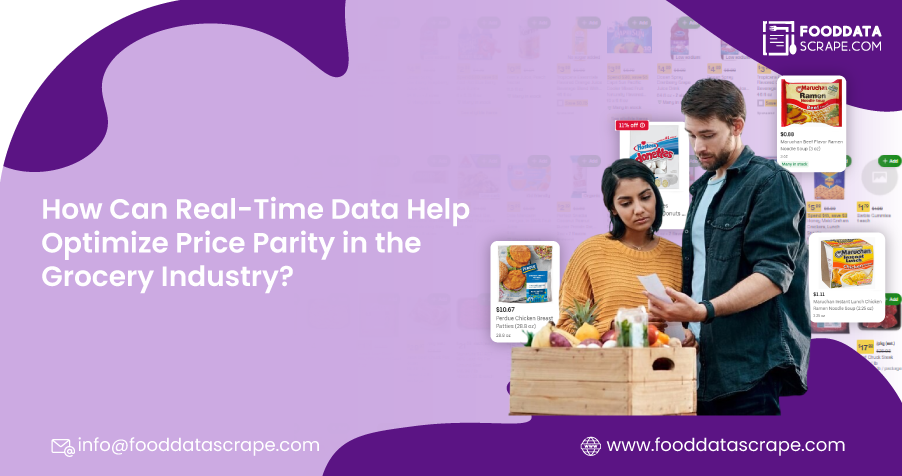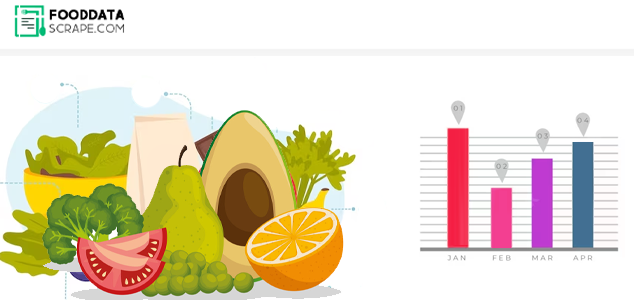Introduction
Price parity is essential for the current competitive retail landscape, especially in the grocery business, to maintain customer confidence and the highest sales. Due to customer price sensitivity, grocery stores are constantly pressured to provide the same prices across channels. Price changes lead to lost business and reduced sales. Companies utilize Grocery Price Parity Scraping Solutions that detect and remove price inconsistencies for their competitiveness. These tools help retailers Scrape Real-time Grocery Pricing across Retailers by having them ready with minute-by-minute data to facilitate better price decisions. Through Real-Time Grocery Price Monitoring Tools, organizations can monitor their competitors' prices and align them based on that. This blog discusses the strategic relevance of grocery price parity, the nature of automated scraping technology, and how it aids in making better pricing strategies. By providing real-time insight, grocery retailers can sustain their competitive edge and deliver customer demand effectively across every sales channel.
Understanding Grocery Price Parity
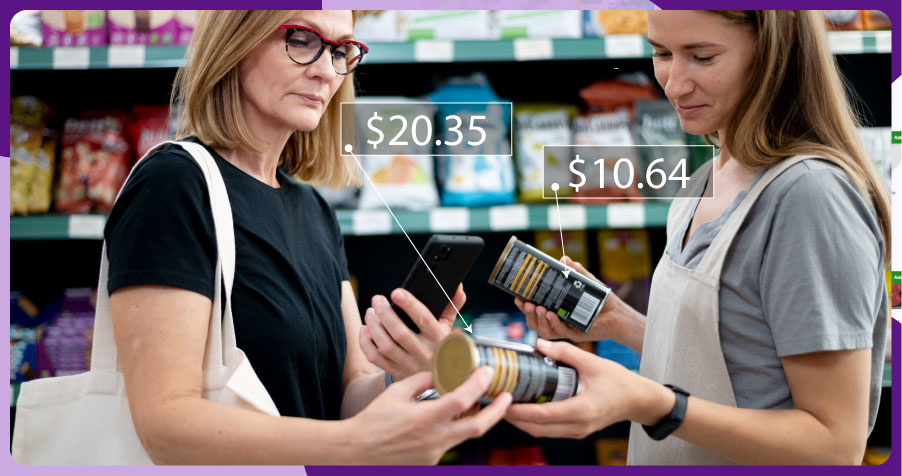
Grocery price parity refers to ensuring that prices for similar products are consistent across different platforms, regions, or stores. For grocery retailers, this means maintaining competitive pricing that matches or outperforms competitors. Grocery Price Intelligence is critical in helping retailers understand market trends and adjust pricing accordingly.
Price parity ensures that customers can trust that they are getting the best value for their purchases, regardless of where they shop. For example, if a customer notices that the price of a specific product is significantly lower on a competitor's website, they may opt to purchase from that store instead. Real-Time Grocery Price Parity Scraping API solutions help retailers monitor these changes as they happen, ensuring pricing remains aligned with the competition.
In the digital era, where e-commerce platforms and brick-and-mortar stores are increasingly intertwined, tracking price parity becomes complex. Scraping Price Parity Data for Grocery Businesses enables retailers to compare prices across multiple sources and respond swiftly to market shifts.
The Challenges of Maintaining Price Parity Across Multiple Grocery Platforms
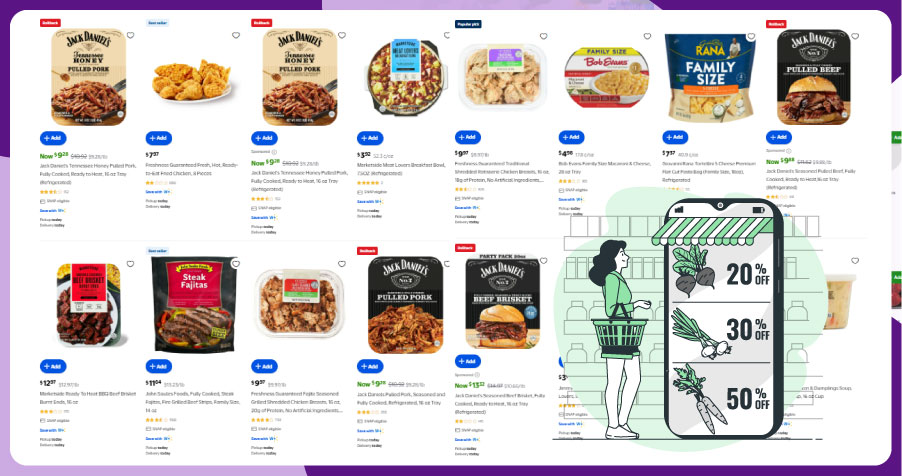
Maintaining price parity across multiple platforms can be a significant challenge for grocery retailers, especially in evolving pricing dynamics. With the rise of online marketplaces, local competitors, and different regional pricing strategies, retailers must constantly monitor various data sources to ensure that their pricing remains consistent. Grocery App Data Scraping Services enable businesses to efficiently extract real-time pricing data from various grocery platforms.
The challenge becomes even more complicated as prices fluctuate frequently due to seasonal promotions, discounts, or changes in supply chains. Retailers must also monitor several platforms simultaneously, from their website to third-party marketplaces like Amazon, Walmart, or Instacart. Web Scraping Quick Commerce Data helps track these rapid price shifts across fast-paced delivery platforms. This requires robust systems to prevent inconsistencies from slipping through the cracks, which could ultimately result in lost sales, reduced customer loyalty, and damaged brand reputation. Grocery Delivery Scraping API Services provide scalable solutions to automate and streamline this critical process.
Automating Competitor Price Tracking with Real-Time Data Scraping
Real-time data scraping is a game-changer in tracking competitor pricing and ensuring price parity across multiple channels. By automating the data collection process, grocery retailers can monitor competitors' prices across multiple e-commerce platforms without the need for manual intervention. Grocery Price Dashboard tools are vital in visualizing this real-time data, helping teams act swiftly.
Scraping tools can be programmed to gather real-time data from competitor websites, social media platforms, and e-commerce stores, ensuring that pricing discrepancies are identified immediately. Grocery Price Tracking Dashboard solutions enhance decision-making by providing a centralized view of live pricing trends and fluctuations.
These automated tools are not limited to basic price monitoring; they also capture key data such as promotions, discounts, and product availability. Grocery Pricing Data Intelligence enables businesses to analyze this rich dataset to inform pricing strategies. By integrating scraping tools with internal pricing systems and Grocery Store Datasets, grocery retailers can create automated workflows that adjust prices based on competitor actions, ensuring consistent pricing across all channels and a better customer experience.
Stay ahead of the competition—leverage our advanced grocery data scraping services now!
The Role of Grocery Price Parity Scraping Solutions
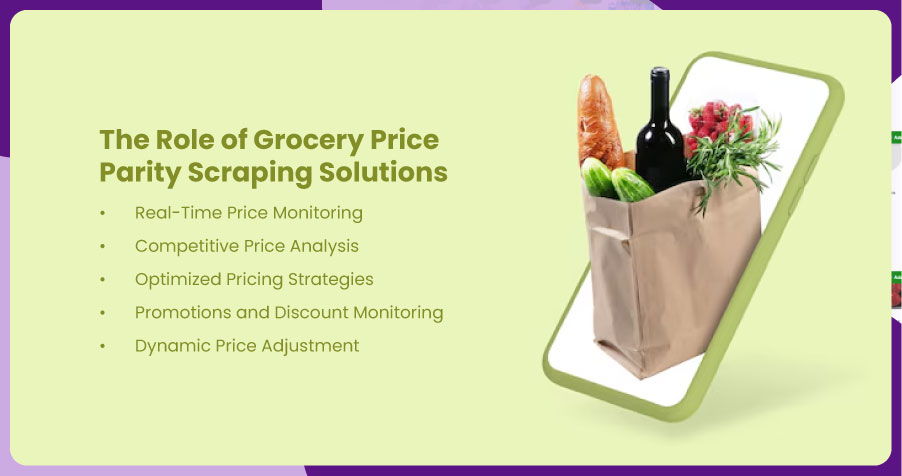
Price parity scraping solutions are automated tools that collect and analyze pricing data from multiple sources. These tools can be programmed to extract information from competitor websites, e-commerce platforms, and even physical stores through price monitoring apps. By gathering real-time data, retailers can identify price discrepancies, track fluctuations, and adjust their pricing strategies.
Here are some of the key roles that grocery price parity scraping solutions play in modern retail:
- Real-Time Price Monitoring: Real-time price monitoring is one of the most significant advantages of price parity scraping. Retailers can track price changes on competitor websites as they happen, ensuring they are always aware of market fluctuations. This is crucial for staying competitive and making timely adjustments to product pricing. Real-time monitoring also helps identify trends in consumer demand, seasonal price shifts, and discounts, allowing retailers to adjust their pricing strategies dynamically.
- Competitive Price Analysis: A critical component of any grocery retailer's strategy is understanding how their prices compare to those of competitors. Price parity scraping solutions help retailers analyze competitive prices by collecting pricing data across multiple competitors. By comparing prices for the same products in different stores, retailers can determine whether they offer competitive rates and are positioned effectively in the market. This analysis enables businesses to identify pricing gaps, potential opportunities for improvement, and areas where they can outperform competitors.
- Optimized Pricing Strategies: With access to real-time competitor data, grocery retailers can develop optimized pricing strategies that help them capture more market share. Price parity scraping solutions provide granular insights into competitor pricing, promotions, and product availability. Retailers can then use this data to fine-tune their pricing models through dynamic pricing, promotional discounts, or bundling strategies. Adjusting prices based on competitor actions is key to maintaining a competitive edge in the grocery market.
- Promotions and Discount Monitoring: Promotions and discounts play a significant role in grocery shopping behavior. Customers are always looking for the best deals, and retailers must be aware of competitor promotions to remain competitive. Price parity scraping solutions track standard product prices and monitor promotional offers and discounts across different grocery stores. This helps retailers assess the effectiveness of their promotions and fine-tune their strategies to attract more customers. Retailers can also identify opportunities to match or beat competitors' discounts, driving higher sales volumes.
- Dynamic Price Adjustment: In today's fast-paced retail environment, adjusting prices quickly in response to market changes is essential. Price parity scraping solutions enable retailers to implement dynamic pricing strategies by collecting and analyzing competitor prices in real time. Retailers can use this data to automate price adjustments based on predefined rules and algorithms. This could include lowering prices to match competitors, increasing prices when demand rises, or offering discounts during slow sales. By automating these adjustments, retailers can stay agile and responsive in a competitive market.
Case Study: A Grocery Retailer's Success with Real-Time Price Parity Monitoring
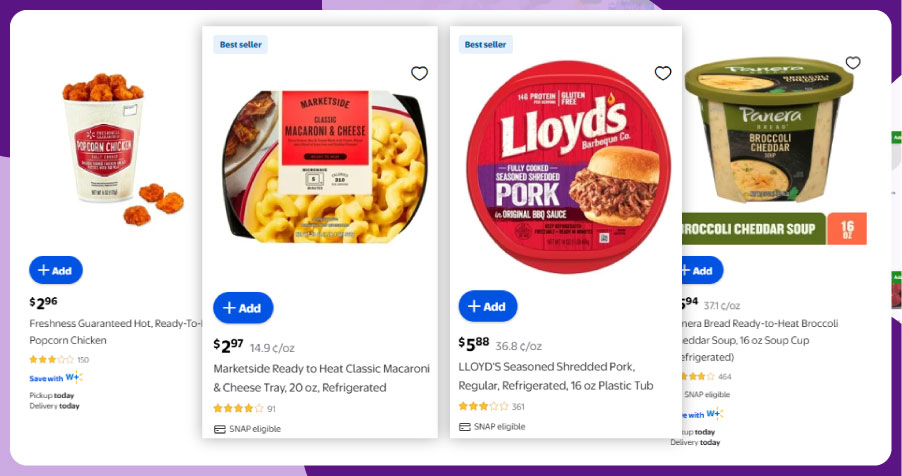
A U.S. grocery retailer used real-time price parity monitoring solutions to improve margins on high-demand products by 12%. By consistently tracking competitor pricing, promotions, and product availability, the retailer identified significant gaps in its pricing strategy. The retailer directly integrated the data from scraping tools into their internal pricing systems, allowing for quick adjustments across various sales channels. The outcome was increased sales, improved customer satisfaction, and a noticeable increase in margins on high-demand products. This case study illustrates how real-time price parity monitoring can substantially improve business performance by ensuring consistent and competitive pricing across all platforms.
Benefits of Grocery Price Parity Scraping Solutions
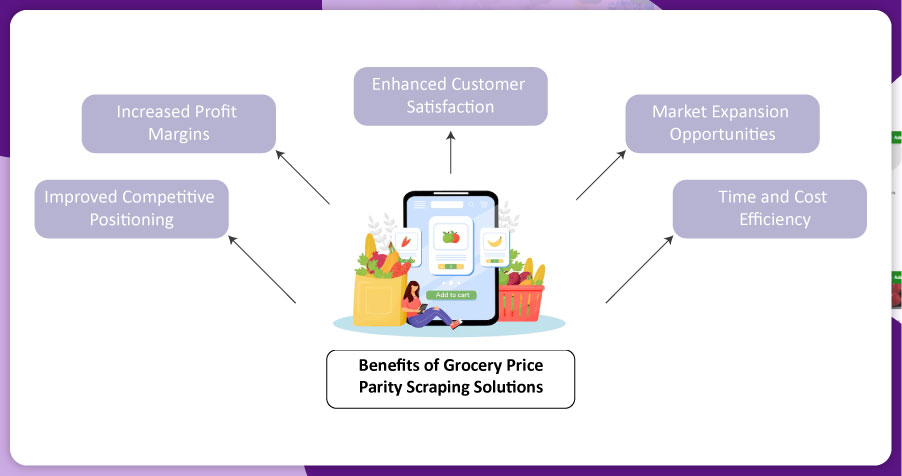
The use of grocery price parity scraping solutions offers numerous advantages for retailers. Here are some of the key benefits:
- Improved Competitive Positioning: Retailers can improve their competitive positioning by constantly monitoring competitors' prices and adjusting their strategies accordingly. Price parity scraping solutions provide detailed insights into how a retailer's pricing compares to the competition, allowing them to make informed decisions about positioning their products in the market.
- Increased Profit Margins: By closely monitoring price parity, retailers can optimize their pricing strategies to maximize profit margins. For instance, if a retailer discovers that a competitor's price is lower for a specific product, they can adjust their price to stay competitive without sacrificing profitability. Similarly, retailers can capitalize on pricing opportunities to increase margins, such as offering value bundles or premium pricing for high-demand products.
- Enhanced Customer Satisfaction: Customers appreciate price transparency and fairness. By using grocery price parity scraping solutions, retailers can ensure they are offering competitive prices that align with customer expectations. This helps build trust and loyalty, improving customer satisfaction and repeat business. Additionally, by offering the best possible prices, retailers are more likely to attract new customers seeking value and savings.
- Market Expansion Opportunities: Price parity scraping solutions can provide valuable insights into regional pricing trends and customer preferences for grocery retailers looking to expand into new markets. By analyzing local competitor pricing, retailers can identify market opportunities, tailor their pricing strategies for specific regions, and confidently enter new markets. This data-driven approach can reduce the risks associated with market expansion and ensure pricing strategies are aligned with local demand.
- Time and Cost Efficiency: Manual price tracking and analysis can be time-consuming and error-prone. Price parity scraping solutions automate the data collection, saving retailers significant time and effort. Automated scraping tools eliminate the need for manual monitoring, allowing businesses to focus on other essential tasks. Additionally, these solutions are often more cost-effective than hiring a dedicated team for price monitoring, making them an attractive option for retailers of all sizes.
Unlock smarter pricing decisions—start using our real-time data scraping solutions today!
Key Considerations When Implementing Grocery Price Parity Scraping
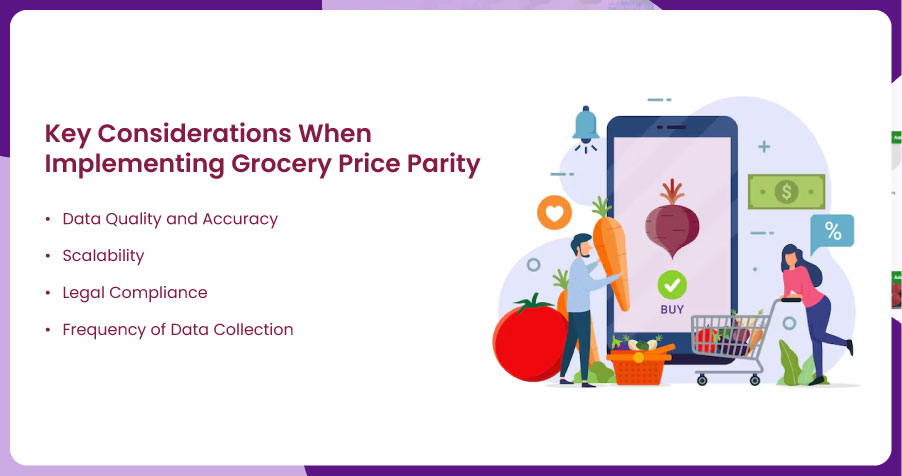
While grocery price parity scraping solutions offer substantial benefits, retailers should keep a few essential considerations in mind when implementing these tools:
- Data Quality and Accuracy: The quality of the data extracted is crucial for making informed pricing decisions. Retailers must ensure that the scraping tools can accurately capture the necessary pricing data and avoid errors that could lead to incorrect analysis.
- Scalability: As grocery retailers grow and expand into new markets, their price monitoring needs will increase. It's essential to choose a scalable scraping solution that can handle an expanding range of data sources, including new competitor websites and e-commerce platforms.
- Legal Compliance: Retailers should ensure that their use of scraping tools complies with legal requirements, including data privacy regulations and intellectual property laws. Some websites may prohibit scraping in their terms of service, so it's essential to be aware of and respect these rules.
- Frequency of Data Collection: The frequency with which pricing data is collected is also essential. Retailers should consider how often competitors update their prices and ensure that their scraping solutions are set to gather data appropriately to stay competitive.
How Food Data Scrape Can Help You?
- Hyperlocal Intelligence Gathering: Unlike generic scrapers, we specialize in collecting region-specific data, like city-level grocery pricing or neighborhood-based restaurant trends, offering unmatched local relevance.
- API-First, Manual-Last Philosophy: Clients love that we provide robust APIs like the Grocery Delivery Scraping API Services, eliminating the need for clunky manual exports or spreadsheets.
- Visual-Driven Data Reporting: Our services are bundled with intuitive visual tools like the Grocery Price Tracking Dashboard, making insights easy to digest even for non-technical teams.
- Zero-Lag Real-Time Monitoring: Thanks to our real-time infrastructure, we deliver live updates—essential for flash sales, time-sensitive grocery deals, and volatile pricing scenarios.
- Customized Data Workflows: Clients rely on our fully tailored scraping pipelines from competitive benchmarking to parity enforcement to match their internal KPIs and decision logic.
Conclusion
Grocery price parity scraping solutions are becoming increasingly essential for retailers who want to maintain a competitive edge in a fast-paced, price-sensitive market. These tools allow for real-time monitoring of competitor pricing, ensuring that grocery stores can adjust their prices to meet customer expectations and outperform competitors. By automating the price collection process, retailers can focus on other aspects of their business while ensuring their pricing strategies remain effective and profitable. Whether for local grocery stores or large retail chains, using grocery price parity scraping tools is a critical component of modern retail success.
Are you in need of high-class scraping services? Food Data Scrape should be your first point of call. We are undoubtedly the best in Food Data Aggregator and Mobile Grocery App Scraping service and we render impeccable data insights and analytics for strategic decision-making. With a legacy of excellence as our backbone, we help companies become data-driven, fueling their development. Please take advantage of our tailored solutions that will add value to your business. Contact us today to unlock the value of your data.






















































































